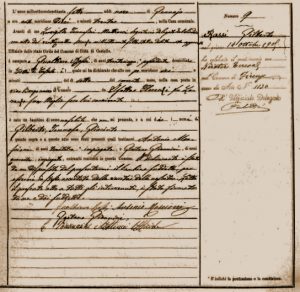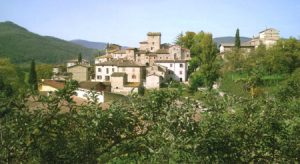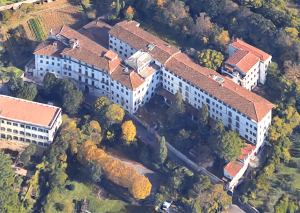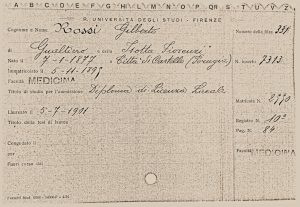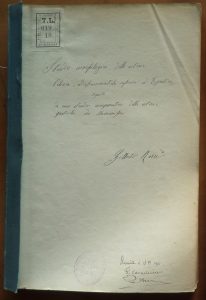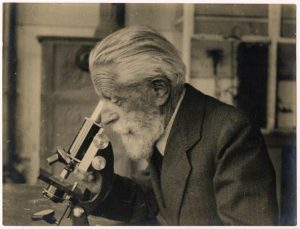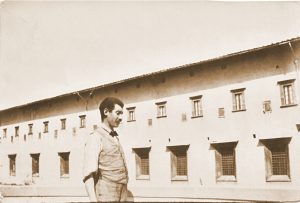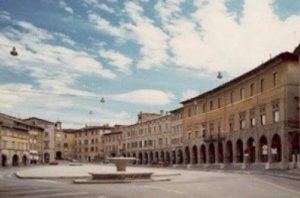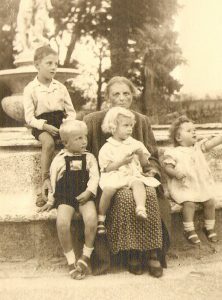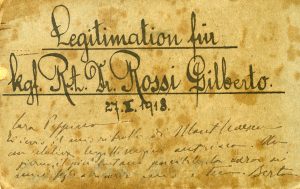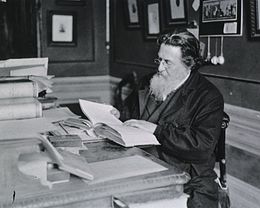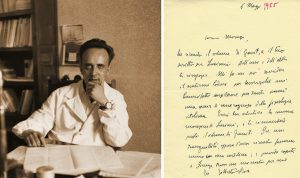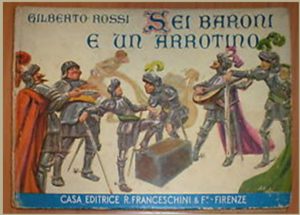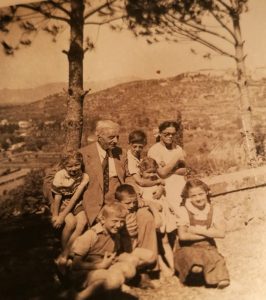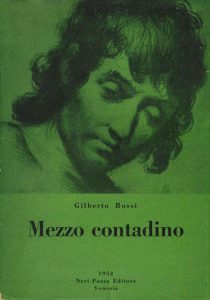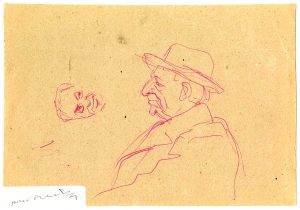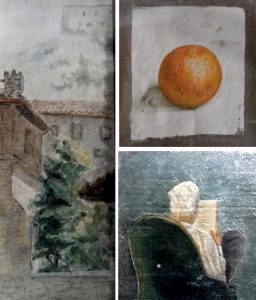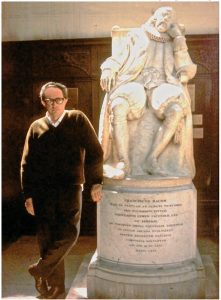by Marco Piccolino and Giovanni Berlucchi
GILBERTO ROSSI, A NEUROSCIENTIST AND AN INTELLECTUAL OF THE NOVECENTO
According to Giulio Cesare Pupilli, Professor of Physiology in the University of Bologna from 1938 to 1963, Gilberto Rossi’s work on the cerebellum was the last luminous product, almost a swan song, of Italian neurophysiology before its decadence in the years of the First World War and the two dark decades of the fascist dictatorship.
A portrait of Gilberto Rossi (1877-1960) in his mature age.
Gilberto Tommaso Giacinto Rossi was born in Città di Castello, near Perugia, on 9th January 1877, the second of the seven children of the patrician landowner Gualtiero Rossi.
Gilberto Rossi’ birth certificate. The right part of the document mentions Rossi’s marriage with Teresa Küster.
Most of the lands and the buildings of the Rossi family, including the 18th century mansion, had been lost during the Restoration following Napoleon’s conquest of the northern part of Italy. Only after long and complex legal proceedings did Gilberto’s grandfather, Tommaso Rossi (1807-1879), succeed in recovering part of the family belongings, particularly a house in Città di Castello and some lands in the nearby hamlet of Badia di Petroia.
Gilberto’s mother, Isotta Fiorenzi, belonged to an aristocratic family from the city of Osimo in the province of Ancona. Gilberto spent his childhood in the rural environment of the high valley of the Tiber river, between his native town Città di Castello and the Badia di Petroia, an experience which marked him for life and deeply shaped his literary work. Indeed, the events of his life in the countryside and the contacts with the farmers and labourers with their difficult struggles for existence will resurface in Rossi’s main literary work, Mezzo contadino (i.e. “Half – peasant”), a pseudo-autobiographic volume written in 1952, when the author was 75 years old and had retired from his University position.
A view of Badia di Petroia, the hamlet with an important abbey where Gilberto Rossi passed long periods of his infancy in tight relation with the rural world.
After being educated – as it was usual for many members of the high social class of the region – at the Alla Querce college of the Barnabite Fathers in Florence, the young Rossi attended the last years of high school at the “Liceo Classico Fratelli Campana” in Osimo, living in the house of his uncle, the Count Francesco Fiorenzi. It is probable that the decision of leaving the Barnabite College in Florence was due to Rossi’s intolerance for the outdated strict discipline of that religious institution. Accordingly, impatience with rigid authorities and a certain revolutionary attitude during the years of his education in an unnamed religious school are the characteristics of the protagonist of Mezzo Contadino.
An aerial view of the location of the Collegio Alla Querce of the Barnabite Fathers in Florence. In this institution Gilberto Rossi received most of his education before enrolling in the Medical School of Florence.
The student record card of Gilberto Rossi from the Historical Archive of the University of Florence (© University of Florence)
The cover of Gilberto’s Rossi’s dissertation for the graduation in medicine in Florence in 1901. The dissertation is in handwriting form. It was supposed to contain various illustrations, which are, however, missing in the copy deposited at the Biomedical Library of the University of Florence. (© University of Florence)
In 1895 Rossi enrolled in the Medical School of Florence (then called “Sezione di Medicina del Regio Istituto di Studi pratici e di Perfezionamento“), obtaining his medical degree in 1901 with a thesis on the comparative morphology of the abdominal arteries supervised by the anatomy professor Giulio Chiarugi. After the graduation he considered the possibility of a medical profession, but eventually opted for a scientific career, despite the many difficulties and possibly oppositions that waited for him in the initial steps along this path.
Giulio Chiarugi (1859-1944), professor of anatomy in the Medical School of Florence, supervised Gilberto Rossi’s dissertation for his graduation in medicine in 1901. A famous anatomist with a strong interest in the functional significance of morphological structures, Chiarugi was one of the leading figures of Florentine science at the time of Rossi’s medical studies.
One of Chiarugi’s collaborators in the years in which Rossi was preparing his dissertation was the young Giuseppe Levi (1872-1965). Levi would become one of the most outstanding biologists of his age, and a famous lecturer at the University of Turin. Among his students in were scholars like Renato Dulbecco, Rita Levi-Montalcini and Salvador Luria, all Nobel prize winners. Born in Trieste, Levi enrolled in the Florence Medical School in 1889 and graduated in 1895 (the year of Rossi’s enrolment). Before becoming a staff member of the anatomical institute (from 1899 to 1909), he worked as a researcher (assistente) in the Psychiatric Clinic of Florence, at the time lated at the San Salvi Hospital. This institution was then directed by the important Italian neurologist and psychiatrist, Eugenio Tanzi (the picture shows Levi within the premises of the hospital). During this period he met Tanzi’s niece, Lidia, then also student in medicine, and married her in 1901. The last of their children, Natalia (1916-1991) was one of the greatest Italian writers of the Novecento. In her masterpiece, Lessico famigliare, published in 1963, Natalia portrayed, in a literary fashion, the stories of Levi’s family and, at the same time, provided a fresco of the progressive milieu of Turin society in an important phase of the modern history of Italy. (© Archivio Famiglia Levi)
Rossi’s choice to start a scientific career was fostered at least in part by the very rich legacy he received from his maternal great aunt, Marietta Caccialupi, the widow of Count Tarquinio Gentili di Rovellone. The Count, a very well off landowner of San Severino Marche, was one of the main experts of numismatic of his age, and the owner of a very important collection of old coins, both of the Roman classic period and of the ancient Pontifical State. The atmosphere of one of the palaces that Gilberto received from Marietta as a part of this legacy, with its many empty halls and the precious old-style decorations of bygone eras, would become an inspiration for one of the most important episodes of the central part of Mezzo contadino.
The circumstances whereby Marietta decided to leave all her belongings to Gilberto are interesting and deserve to be narrated in some details, based on an unpublished manuscript of Serena Rossi, the granddaughter of Gilberto’s elder brother Mario. Serena writes that, being childless, Marietta was supposed to bequest all her properties to a nephew belonging to both sides of the family. However, matters took another course, following an episode that occurred when she was 89 years old. In her palace there were many valuable objects, including a plate of the ancient manufacture of Deruta that she liked particularly. Since the sight of Marietta had been badly worsening, probably due to a cataract, she looked for treatment and asked the advice of Gilberto, who suggested her to consult an important ophthalmologist of Rome. The doctor came to San Severino Marche, did the surgery, and Marietta recovered her sight. With her improved vision she realized, to her great disappointment, that the famous Deruta plate was a fake. Having found out that her nephew had sold the original item and substituted it with a copy, she decided to disinherit him. Aware of that decision, Gilberto’s mother intensified her visits to Marietta, bringing every time one or the other of her seven children, with the hope that one of them could be made the heir of her immense fortune. This expectation proved right. The choice eventually fell on Gilberto, probably because of his looks of a very serious young man, especially when compared with the previous spendthrift and unreliable candidate, and perhaps also because Marietta was grateful to him for helping her recover her sight.
Piazza del Popolo at San Severino Marche, with, on the right, the Palace Gentili di Rovellone. This palace was left as a legacy to Gilberto by the owner, Marietta Caccialupi, after the complex circumstances described in the text.
In 1909 Rossi married Teresa Küster, a young woman belonging to a Lombard family of foreign ascendance, from whom he had two sons, Gualtiero and Alberto.
Teresa Küster, Gilberto Rossi’s wife, with her grandchildren in a picture taken around 1943.
But for a brief period spent in 1913 at the University of Perugia, Rossi’s entire academic career took place in Florence. After teaching biology, biochemistry and physiology, in 1918 he succeeded Giulio Fano, who had moved to the University of Rome, as director of the physiology laboratory and then, after winning a national competition, as full professor of physiology, a position which he held from 1923 until his retirement in 1947.
Rossi volunteered to take part in the First World War when he was almost forty, as an infantry soldier, not wishing to benefit of the privilege of serving as a medical officer, as was his right as a graduate in medicine. However, after being recognized on the field by a former student, he was made a medical captain. He received a bronze medal for his abnegation in taking care of the wounded at the battlefront, and was taken prisoner following the Italian disastrous defeat at Caporetto. The events of Gilberto Rossi participation in the First World War are remembered by his nephew, the great Italian philosopher and science historian Paolo Rossi, in his text Sulla guerra, Fine di un mito, published in 2008 in a volume edited by Alvaro Tacchini. In commenting the circumstances leading to Gilberto’s bronze medal, Paolo remarks, by citing the words of the award motivation, that the duty of the medical officers was exclusively that of treating the soldiers wounded during the battles, not to bring back them to the infirmary from the battlefield, a duty of the porters of the regiment. Confronted with the hesitation (or perhaps the refusal) of a coward porter, “the forty years old medical captain Gilberto Rossi of the ‘86th Infantry Regiment reached a wounded soldier ‘in a zone heavily beaten by the artillery’, gave him the first aid and, together with another soldier, transported him to the medication post.”.
A portrait of Gilberto Rossi as Medical Captain during the First World War.
The note accompanying the Rossi’s portrait sent to his sister Giuseppina during the period of his imprisonment by the Austrians during the First World War.
The experience of the tragic futility of the war, which also caused the death of his younger brother Astolfo, scarred Gilberto permanently, contributing to the pessimism that transpires from his writings, as well as to his outspoken aversion to fascism. Some of the episodes of the war that Gilberto Rossi annotated in his notebook will resurface in the third part of Mezzo contadino.
In the Second World War Rossi was commissioned to head a military centre for chemical research established in the Institute of Physiology for the improvement of anti-gas masks. During the Italian occupation by the Nazis he refused to communicate them the results of these researches, and succeeded in defending the equipment and the library of the Institute against the looting by the occupants. This was made possible also thanks to the acquiescence of a German officer (possibly a physiologist of Heidelberg, Hans Nothdurf) who knew him by fame and appreciated his scientific work.
Eventually, however, in order to avoid the retaliations from the fascists, Rossi had to take shelter in the Florence centre of mental hygiene headed by his former pupil and co-worker Gino Simonelli.
Rossi was a fine intellectual endowed with a sharp critical power, but – because of his austere and withdrawn personality – he always shied away from any ostentation of his value as a man and a scientist. Compared with the academic and scientific cosmopolitanism of Moritz Schiff, Luigi Luciani e Giulio Fano, his predecessors on the chair of physiology in Florence, Rossi’s university career may give an impression of provincialism. Fiercely attached to his Florence laboratory, he never collaborated with other research centres in Italy or abroad, in that regard having an attitude similar to Giulio Chiarugi, his dissertation supervisor. Rossi published most of his papers, usually as sole author, in the Archivio di fisiologia, the journal founded by Fano and afterwards edited for many years by Rossi himself. Despite his seeming disinterest for the visibility of his research work in the national and international scientific community, some of his discoveries have had a wide and long-lasting resonance in physiology and particularly in neurophysiology.
For more than a decade after graduating in medicine, Rossi’s work did not reveal any interest for the nervous system, being devoted to topics in comparative physiology, biochemistry and biophysics as disparate as the crop and gizzard motility in chickens, the viscosity of blood serum and other biological fluids, the intestinal absorption of fats and other organic molecules. These are serious works using original experimental techniques and aimed at revealing the determinism of precise physiological phenomena, but it is not in them that one should seek the reasons for Rossi’s scientific fame.
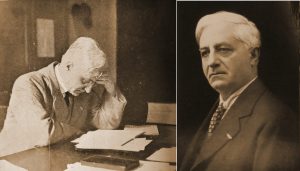 Gilberto Rossi during the years of his professorship at the University of Florence.
Gilberto Rossi during the years of his professorship at the University of Florence.
Rossi’s debut in the neurophysiological literature occurred in 1912 with the publication of two notes on the functional relations between the cerebellum and the anterior part of the brain. In these notes he reported the results of researches carried out in the laboratories of via Capponi where many years previously Luciani had performed his famous experiments on the effects of chronic cerebellar lesions in dogs and monkeys. In the first note he reported that the removal of half of the cerebellum in dogs resulted in an immediate decrease of the electrical excitability of the cortical motor zone of the opposite hemisphere, followed, some time later, by an increase of the excitability of the same zone. In the second note, the most important for Rossi’s scientific fame, the electrical or chemical (with strychnine) stimulation of a few zones of a cerebellar hemisphere was reported to have no motor effect by itself, but to lower the threshold for the excitation of the contralateral motor cerebral zone: currents too weak to cause by themselves movements from the motor cortex became effective during the cerebellar stimulation. These results clarified the mechanism of the reinforcing (“stenic”) action of the cerebellum on the cerebrum as hypothesized by Luciani and demonstrated the crossed organization of such action. Rossi had never worked with Luciani, but Luciani was familiar with his experiments and probably had inspired them, as suggested by the fact that he described them in a very appreciative manner in his treatise on the Physiology of Man, predicting a bright future for Rossi in the experimentation on the cerebellum. The notoriety conferred to Rossi’s works by Luciani’s approval was soon followed by an international reputation mostly due to the translation of Luciani’s treatise in many languages. The supervision of the English translation of the volume containing the part on the cerebellum was entrusted to the neurologist Gordon Holmes, an expert on cerebellar disorders in man who realized the importance of Rossi’s experimental results for the understanding of human cerebellar pathologies and cited them in his publications. In the final synthesis of his cerebellar work, Holmes reaffirmed the probable connection between the mechanism discovered by Rossi in dogs and the weakness which afflicts the movements of the limbs ipsilateral to a neocerebellar lesion in man.
Luigi Luciani (1840-1919) was an important Italian pathologist and physiologist, famous especially for his works on the cerebellum and for his physiological treatise translated in various languages. He was a reference figure for the young Rossi as well as an influential sponsor of his research. Luciani was professor of physiology in Florence until 1893, before Rossi enrolled in the Medical School, and then in Rome.
Rossi’s results were experimentally replicated by first-rate neurophysiologists like Bremer, Dusser de Barenne and Fulton, with the addition of an electroencephalographic confirmation obtained by Walker in Bremer’s laboratory. Making an exception to his usual modesty, toward the end of his career Rossi published a review with extended quotations of all the papers of the authors supporting his work. However, he never referred to his major discovery using the expression “Rossi effect” which has been widely used in the literature regarding the cerebellum after the publication of a monograph by Dow and Moruzzi in 1958.
Based on what we know today about the cerebellar circuits, it is difficult to explain the Rossi effect, i.e. a facilitation of the motor cortex by a stimulation of the contralateral cerebellar cortex, in neuronal terms. The projections from the cerebellar dentate nucleus to the contralateral motor cortex via the thalamus are no doubt facilitatory, but the cerebellar cortex has an inhibitory action on the dentate nucleus. Rossi himself was always very cautious in proposing neuronal interpretations of his effect, and as late as in 1940 he stated that his results did not allow him to attribute the cerebellar facilitation of the motor cortex to an excitability change occurring in the cortex itself or downstream from it.
After the successful experimental notes of 1912, research work in Rossi’s laboratory was largely centered on cerebellar physiology, with the exception of studies on the vestibular labyirinth which led to original results with regard to the inertial movements of the endolymph in the vestibular canals and to the labirynthine reflexes. After 1921 the subject of the researches on the cerebellum was a new phenomenon discovered by Rossi: the postural and motor asymmetries occurring in cats and dogs after destructions of unilateral portions of the neocerebellum corresponding in part to those involved in the Rossi effect. When the animal with unilateral cerebellar lesions lies on its back or is suspended in a vertical position, the anterior limb unilateral to the lesion is more flexed than the opposite limb, and the strength of movements of the two limbs is a function of the initial postural asymmetry. In these experiments Rossi was helped by his two closest co-workers: Gino Simonelli, who eventually gave up his career in physiology to work as a psychiatrist, and Anna Maria Di Giorgio who was full professor of physiology in Siena and Turin.
The former Rossi’s student, Gino Simonelli (the first at the left) with the group of psychiatrists of the San Salvi Clinic in Firenze. The picture was taken in 1916, on the occasion of the 60th anniversary of the birth of Eugenio Tanzi (1856-1934: the person seated at the left). Tanzi, one of the founders of psychiatry in Italy, was the director of the institution. Seated near him is Ernesto Lugaro (1870-1940), Tanzi’s student and an important scholar, who contributed in a significant way to the study of the structure and function of the nervous system. In the last part of his academic career, Lugaro was appointed professor of Nervous and Mental Diseases in Turin and became a friend of Giuseppe Levi. Both Tanzi and Lugaro are alluded to in Lessico famigliare, the remembrance book written by Levi’s daughter (and Tanzi’s grandniece), Natalia Ginzburg.
In one of the papers on the postural asymmetries, Rossi’s sharp physiological intuition led him to hypothesize that the muscle tone could be simply regulated by the length, and therefore the sensitivity, of the muscle spindles, in turn determined by a motor innervation, unknown at that time, of the spindles themselves. From this intuition Rossi gained almost as much fame as from his eponymous effect. Ragnar Granit, a future Nobel prize winner for physiology and medicine in whose Stockholm laboratory the motor innervation of muscle spindles was discovered and analyzed in depth, wrote in 1953 with Eldred and Merton that “the part played by intrafusal muscle contraction in reflex action was first adumbrated in the penetrating hypothesis of Rossi (1927)»
The scientific standing of Rossi was recognized in his country with the ascription to the Accademia dei Lincei as a correspondent in 1928 and the election to national member in 1947.
Among the colleagues who nurtured a great scientific and human esteem for Gilberto Rossi there was Giuseppe Moruzzi (1910-1986), one of the greatest physiologists of the 20th century, particularly well known for his research on the reticular system of the brainstem and the control of the sleep-waking cycle. In the left image Moruzzi is portrayed in his office at the Institute of Physiology of the University of Pisa; on the right is a kind letter that Rossi sent to his younger colleague in 1955, acknowledging the receipt of a volume of Granit and of a necrology of Luciani written by Moruzzi. Moruzzi wrote two necrologies of Rossi. A short one, appeared in 1960 on The Journal of Neurophysiology, and left unsigned, can be read by clicking here: Moruzzi Rossi JNP 1960. A longer one appeared in the same year on the Archives Italiennes de Biologie; you can download it by clicking here: Moruzzi Rossi AIB 1960.
Rossi was endowed with a solid humanistic culture, nourished by his knowledge of the Latin and Greek classics, of the great works of the Italian literature (with a predilection for the texts of Giacomo Leopardi and Alessandro Manzoni), and of the classics of the political and scientific literature of Tuscany (particularly the texts of Niccolò Machiavelli, Francesco Guicciardini and Francesco Redi). In his mature years he became acquainted also with the great classics of the foreign literature (mainly the masterpieces of the great French and Russian writers, but also those of the American and English literature). His humanistic interests were especially nurtured by his elder brother Mario, the father of Paolo the philosopher and science historian. Mario introduced his brother to the lively Florentine literary life of those times and to the Beltrami bookstore of via Martelli which was a meeting place for writers like Giovanni Papini, Aldo Palazzeschi and the psychiatrist Corrado Tumiati, Gilberto’s former mate at the La Querce College.
Rossi’s first literary works were published at the end of his academic career, although some of them were written many years before. This is the opinion of Matilde Luisa Baroni, the author of a dissertation on Rossi’s literary works, largely based on documents which are no longer extant. In 1946 Rossi published a short novel for children entitled Sei baroni e un arrotino (“Six barons and one knife sharpener”). In 1947, due to the encouragement of Tumiati, he began a collaboration with the literary magazine Il Ponte (recently founded by Pietro Calamandrei), and – starting in 1952 – he freelanced for the magazine of the Italian writers-physicians, La Serpe (founded and directed by Tumiati himself). Another short novel for children, La rivolta degli Uno (The revolution of the numbers One), of a considerable literary quality, was published by Rossi in 1951. On the next year the Venetian publisher Neri Pozza, who was also a literary critic, published Rossi’s main literary work, the already mentioned Mezzo contadino. This novel was awarded an important literary prize (Premio Marzotto – Opera prima) and gave the author some degree of fame in Italian as well as certain foreign literary circles. It attracted the attention of renowned literary critics of the time, like Giovanni Grazzini, Giuseppe De Robertis and Piero Pancrazi.
The cover image of Sei baroni e un arrotino, the first of Gilberto Rossi’s publication of non scientific character. The text was a short novel for children and was initially created by Rossi only to be narrated to his children and grandchildren.
The cover image and two more illustrations from La Rivolta degli Uno, published in 1951. Although written for children, this important text of a high literary quality demonstrates some of the main gifts of Rossi as a writer: humour, creativity, linguistic research and understatement. A copy of this very rare book can be downloaded from the following site: La Rivolta degli Uno
Gilberto Rossi with his grandchildren, in a picture taken in the Tuscan countryside near Pisa. The children of the family were enchanted by the fairy tales and other stories that Rossi frequently invented himself and narrated to them.
Some of Rossi’s literary texts have remained unpublished, while others were published in 1960, soon after his death, with a foreword of Corrado Tumiati and a remembrance of his son Gualtiero.
The cover image of Mezzo contadino, the main literary work of Gilberto Rossi, published in 1952 by Neri Pozza in Venice.
The main literary work of Rossi, Mezzo contadino, has, at least in part, characteristics similar to other texts that normally he used to write on notebooks (his quadernacci) for an exclusive fruition within his familiar circle. Among these common characteristics are a disenchanted pessimism (the “virile mestizia” – virile melancholy – noted by Pancrazi in his reviews of the volume), a didactic attitude (especially evident in the first part of the work, dedicated to the description of events of the peasant world), and a particular attention to the stylistic and linguistic research, with the usage of a Tuscan language, refined but not pedantic.
As already noted, in Mezzo contadino, Rossi inserts real episodes of his own life, from the infancy in the religious college or in contact with the peasant world, the youthful years in boarding houses in Florence with attitudes reminiscent of the Bildungsroman and also – as it has been said – a certain “scapigliatura lombarda”, and, finally, episodes of his experience during the First World War. The text is written in a way likely to mislead a reader looking for a real autobiography of the author. Rossi was certainly not the child of poor peasants, nor was he the eternal penniless student, or the country physician in the role of the first person narrator of the novel. Possibly only the war events are narrated with a certain precision on the basis of the memories annotated in the author’s notebooks. Most of the readers who were not acquainted with Rossi did not suspect that the book was the work of a scientist internationally known for his studies in many fields and particularly in the physiology of the cerebellum. It is indeed surprising that the novel lacks any reference to the scientific endeavours of the narrator. Perhaps the only passage which refers to the real Rossi is the discussion on Darwinism, where the author might be identified not in the narrator, but in “the medical student, son of an affluent landowner”, who “had got in his head to become a scientist, and even a great scientist”.
Among the attendants of Florentine literary circles where Gilberto had been introduced by his brother Mario there were not only writers and literary critics, but also artists, and particularly painters like Ardengo Soffici, Luigi Michelacci, Piero Bernardini and others.
A drawing representing Gilberto Rossi in his advanced age, made by the Florentine artist, Piero Bernardini (1891-1974), one of the habitués of the Libreria Beltrami, a meeting point for intellectuals and artists. (© Museo Galileo, Florence, Italy)
Rossi himself had some artistic talent in painting and drawing, as manifested in the anatomical illustrations that he made as a medical student and in some delicate watercolour images that he painted for his family circle.
Artistic talents in Gilberto Rossi’s home. Left and at the top right: two watercolours of Gilberto Rossi, the first one being a view of San Severino Marche. Bottom right: Gilberto Rossi in a painting of his son Alberto.
Gilberto Rossi died in Florence after a heart attack on 20th March 1960. Remembrances and obituaries of him have been written by his former students, collaborators and colleagues.
Gilberto’s nephew, Paolo Rossi (1923-2012), has been one of the greatest intellectuals of Italian Novecento. He is particularly famous for his studies on history of science, the importance of magic in the scientific revolution and on the fundamental role of Francis Bacon in the emergence of modern science. This picture, taken in 1970, in the Trinity College of Cambridge, portrays him near the stature of the Lord Chancellor. In his text Sulla guerra Paolo remembers his uncle with these words:
I remember uncle Berto, who was professor of physiology in the Faculty of Medicine; he was a highly respected scholar and also a member of the Accademia dei Lincei. When I was a child, he told me many fairy tales that I still remember. When he retired from the university, these tales were published, together with a “poetic autobiography”, entitled Mezzo contadino. In the following years, he taught me very many things of literature and animal and human physiology, and gave me not a few advices. He never spoke to me about the war and his medal. He belonged to the category of persons that I have mentioned above with reference to Shakespeare’s Henry IV: for them “the earthy and cold hand of death lies on [their] tongue”. I dedicate these pages to his memory.
Acknowledgements: the research on which this web site is based has been partially sponsored by a grant from the Federation of the European Neuroscience Societies (FENS) to Giovanni Berlucchi. The authors are deeply indebted to Vincenzo, Isotta and Luigi Rossi, Gilberto’s grandsons, for providing materials and information concerning their grandfather. They thanks also Fioranna Salvadori and Laura Vannucci of the University of Florence, Livia Iannucci of the University of Pisa and Sabina Bernacchini of the Museo Galileo of Florence for their valuable assistance during the research on Rossi’s life and scientific activity.
References:
L. Luciani, Human physiology, I, London 1915, p. V; III, edited by G.M. Holmes, 1915, pp. 483 and following. G. Holmes. The cerebellum of man. Brain, 63: 1-30, 1939. I. Spadolini, Nel settantesimo compleanno di Gilberto Rossi, in Archivio di Fisiologia, 1947, vol. 47, pp. 210-231; E. Eldred – R. Granit – P.A. Merton, Supraspinal control of the muscle spindles and its significance, in The journal of physiology, 1953, vol. 122, pp. 498-523; R.S. Dow – G. Moruzzi, The physiology and pathology of the cerebellum, Minneapolis 1958, pp. 311, 316; A.M. Di Giorgio, Gilberto Rossi, in Archivio di Scienze Biologiche, 1960, vol. 44, pp. 520-526; G. Moruzzi, Gilberto Rossi, in Archives Italiennes de Biologie, 1960, vol. 98, pp. 222-225; G. Simonelli, Commemorazione del Prof. Gilberto Rossi, in Lo sperimentale, CX (1960), pp. 480-492; C. Tumiati, G. R. (1877-1960), ibid., pp. 493-497; M.L. Baroni, G. R., unpublished Dissertation, Università degli studi di Urbino, 1965. G.C. Pupilli, Gustavo Colonnetti e le ricerche di neurofisiologia in Italia. Bologna, 1972. G. Filogamo, Giuseppe Levi. In: R. Allìo (ed.), Maestri dell’Ateneo torinese dal Settecento al Novecento, Torino, 2004 (pp. 101-114). P. Rossi Sulla guerra, Fine di un mito, in “L’Alta Valle del Tevere e la Grande Guerra”, Città di Castello 2008.
Articles of Gilberto Rossi cited in the text:
Rossi G. Ricerche sulla eccitabilità della corteccia cerebrale in cani sottoposti ad emiestirpazione cerebellare. Arch. Fisiol., 10: 257-260, 1912.
Rossi G. Sugli effetti conseguenti alla stimolazione contemporanea della corteccia cerebrale e di quella cerebellare. Arch. Fisiol, 10: 389-399, 1912.
Rossi G. Sulle localizzazioni cerebellari corticali e sul loro significato in rapporto alla funzione del cervelletto. Arch. Fisiol., 19: 391-445, 1921.
Rossi G. Asimmetrie toniche posturali ed asimmetrie motorie. Arch. Fisiol., 25: 146-157, 1927.
Rossi G. Ricerche sul laberinto vestibolare eseguite nell’Istituto di Fisiologia di Firenze. Arch. ital. Anat. Embriol., 33: 38-66, 1934.
Rossi G. Azione del cervelletto sulla corteccia cerebrale. Arch.Fisiol., 40: 419- 437, 1940.
A more exhaustive scientific bibliography can be found in the article on Gilberto Rossi written by his pupil Igino Spadolini in 1947, at the time of Rossi’s jubilation. To download this article click here: Spadolini_Rossi_Arch_Fisiol_1947
The “Risorgimento” of Physiology in post-risorgimental Italy
Angelo Mosso, Giulio Fano, Moritz Schiff and Jacob Moleshott, four eminent physiologists in post-risorgimental Italy.
Angelo Mosso (1846-1910), Luigi Luciani (1840-1919) and Giulio Fano (1856-1930) were eminent representatives of Italian physiology in the 19th century. For their scientific and cultural merits, they all became in due course senators of the Kingdom of Italy. All of them had received a formative education in experimental physiology during their stay at the laboratory of Carl Ludwig in Leipzig, at that time the Mecca for aspirant physiologists from all over the world. Mosso is regarded as the precursor of the modern technology of brain imaging, and Luciani was one of the fathers of cerebellar physiology and a pioneer of the localization of brain functions. Mosso and Fano had both graduated in medicine in Turin, where they had been attracted to scientific research by the influence of the great biologist Giulio Bizzozero (1846-1901) . After experiences in various laboratories, including that of Moritz Schiff in Florence (see below), Mosso started his university career in physiology as a disciple of Jakob Moleschott, the Dutch scientist who had been called to the chair of physiology in Turin by Francesco de Sanctis (1817-1883), the first minister for public education of the newly born Kingdom of Italy. When Moleschott (1822-1893) moved to the University of Rome “La Sapienza”, Mosso succeeded him as professor of physiology in Turin, and Fano was one of his first assistants. Luciani had graduated in Medicine in Bologna and had at first taught pathology in Parma, before being called to the chair of physiology in Florence, where Fano joined him as his aiuto (deputy) and eventually successor.
The city of Florence did not have a proper University until 1924, but a Medical School existed since the 13th century at the Santa Maria Nuova Hospital. In 1859 the government of the city, which in six years would become the provisional capital of Italy, established the Regio Istituto di Studi Superiori Pratici e di Perfezionamento for the teaching of Medicine and Surgery, Natural Sciences and Philosophy and Philology. The Laboratory of Physiology, housed from 1862 to 1936 in a building in via Gino Capponi near the Church of the Santissima Annunziata, was initially headed by a man who had come from abroad, on the recommendation of Carlo Matteucci (1811-1869), the famous physicist and electrophysiologist of the Pisa University (and also Minister of the Public Instruction for a short period). The German Moritz (Maurizio) Schiff (1823-1896), a pupil of Johannes Müller, of eponynimal fame in neurophysiology for the Schiff-Sherrington phenomenon, taught physiology in Florence for 15 years. His class demonstrations of the effects of brain lesions in unanesthetized animals raised the opprobrium of Italian and British antivivisectionists and forced him to leave the city and move to the University of Geneva. He was succeeded by his disciple Alexandr (Alessandro) Herzen (1839-1906), a Russian emigré who took upon himself the task of instructing the Florentine population on Darwin’s theories and on the identity of physiology and psychology as revealed by the scientific knowledge of brain function. His outspoken materialism raised harsh criticisms from the Catholic Church and eventually he also had to leave for Switzerland to teach at the University of Lausanne. His place was taken in 1882 by Luciani who did the most important part of his work on the cerebellum in Florence, before being called in 1893 to the chair of physiology in the Faculty of Medicine of the University of Rome “La Sapienza”as successor to Moleschott. Fano worked as Luciani’s deputy only for two years before going to the University of Genoa where he became full professor in 1885. As the successor of Luciani, he held the physiology chair in Florence from 1894 to 1916, before going to the University of Rome as professor of physiology in the Science Faculty. Fano was a man of wide culture and a polyglot who travelled the world and described his travels in a successful book. As a physiologist he worked in many disparate fields, with a particular interest in the nervous and circulatory physiology of the pound tortoise. He had the merit of detecting Gilberto Rossi’s promise as a young experimenter in physiology, so that he appointed him as his deputy and published with him three studies on the viscosity of the blood and other organic fluids. Rossi succeeded Fano both as professor of physiology in Florence and editor of the “Archivio di Fisiologia”, the first Italian journal specializing in physiology, founded by Fano in 1904. It is interesting that it was Rossi, rather than Fano, who kept alive some of Luciani’s research interests in neurophysiology, even though Rossi joined the physiological laboratory after Luciani moved to Rome, and therefore never worked directly with him.

